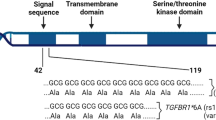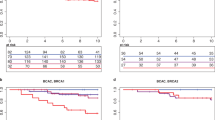Abstract
Klotho is a transmembrane protein that can be shed and act as a circulating hormone and is a putative tumor suppressor in breast cancer. A functional variant of KLOTHO (KL-VS) contains two amino acid substitutions F352V and C370S and shows reduced activity. Germ-line mutations in BRCA1 and BRCA2 substantially increase lifetime risk of breast and ovarian cancers. Yet, penetrance of deleterious BRCA1 and BRCA2 mutations is incomplete even among carriers of identical mutations. We examined the association between KL-VS and cancer risk among 1115 Ashkenazi Jewish women: 236 non-carriers, 631 BRCA1 (185delAG, 5382insC) carriers and 248 BRCA2 (6174delT) carriers. Among BRCA1 carriers, heterozygosity for the KL-VS allele was associated with increased breast and ovarian cancer risk (hazard ratio 1.40, 95% confidence intervals 1.08–1.83, P=0.01) and younger age at breast cancer diagnosis (median age 48 vs 43 P=0.04). KLOTHO and BRCA2 are located on 13q12, and we identified linkage disequilibrium between KL-VS and BRCA2 6174delT mutation. Studies in breast cancer cells showed reduced growth inhibitory activity and reduced secretion of klotho F352V compared with wild-type klotho. These data suggest KL-VS as a breast and ovarian cancer risk modifier among BRCA1 mutation carriers. If validated in additional cohorts, the presence of KL-VS may serve as a predictor of cancer risk among BRCA1 mutation carriers.
This is a preview of subscription content, access via your institution
Access options
Subscribe to this journal
Receive 50 print issues and online access
$259.00 per year
only $5.18 per issue
Buy this article
- Purchase on Springer Link
- Instant access to full article PDF
Prices may be subject to local taxes which are calculated during checkout



Similar content being viewed by others
References
Antoniou AC, Easton DF . (2006). Models of genetic susceptibility to breast cancer. Oncogene 25: 5898–5905.
Antoniou AC, Goldgar DE, Andrieu N, Chang-Claude J, Brohet R, Matti A et al. (2005). A weighted cohort approach for analysing factors modifying disease risks in carriers of high-risk susceptibility genes. Genet Epidemiol 29: 1–11.
Antoniou AC, Sinilnikova OM, Simard J, Léoné M, Dumont M, Neuhausen SL et al. (2007). RAD51 135G’C modifies breast cancer risk among BRCA2 mutation carriers: results from a combined analysis of 19 studies. Am J Hum Genet 81: 1186–1200.
Antoniou AC, Spurdle AB, Sinilnikova OM, Healey S, Pooley KA, Schmutzler RK et al. (2008). Common breast cancer-predisposition alleles are associated with breast cancer risk in BRCA1 and BRCA2 mutation carriers. Am J Hum Genet 82: 937–948.
Arking DE, Atzmon G, Arking A, Barzilai N, Dietz HC . (2005). Association between a functional variant of the KLOTHO gene and high-density lipoprotein cholesterol, blood pressure, stroke, and longevity. Circ Res 96: 412–418.
Arking DE, Becker DM, Yanek LR, Fallin D, Judge DP, Moy TF et al. (2003). KLOTHO allele status and the risk of early-onset occult coronary artery disease. Am J Hum Genet 72: 1154–1161.
Arking DE, Krebsova A, Macek Sr M, Macek Jr M, Arking A, Mian IS et al. (2002). Association of human aging with a functional variant of klotho. Proc Natl Acad Sci 99: 856–861.
Begg CB, Haile RW, Borg A, Malone KE, Concannon P, Thomas DC et al. (2008). Variation of breast cancer risk among BRCA1/2 carriers. JAMA 299: 194–201.
Cha S-K, Ortega B, Kurosu H, Rosenblatt KP, Kuro-O M, Huang C-L . (2008). Removal of sialic acid involving Klotho causes cell-surface retention of TRPV5 channel via binding to galectin-1. Proc Natl Acad Sci 105: 9805–9810.
Chen C-D, Podvin S, Gillespie E, Leeman SE, Abraham CR . (2007). Insulin stimulates the cleavage and release of the extracellular domain of Klotho by ADAM10 and ADAM17. Proc Natl Acad Sci 104: 19796–19801.
Hudelist G, Wagner T, Rosner M, Fink-Retter A, Gschwantler-Kaulich D, Czerwenka K et al. (2007). Intratumoral IGF-I protein expression is selectively upregulated in breast cancer patients with BRCA1/2 mutations. Endocr Relat Cancer 14: 1053–1062.
Imura A, Iwano A, Tohyama O, Tsuji Y, Nozaki K, Hashimoto N et al. (2004). Secreted Klotho protein in sera and CSF: implication for post-translational cleavage in release of Klotho protein from cell membrane. FEBS Lett 565: 143–147.
Ito S, Kinoshita S, Shiraishi N, Nakagawa S, Sekine S, Fujimori T et al. (2000). Molecular cloning and expression analyses of mouse [beta]klotho, which encodes a novel Klotho family protein. Mech Dev 98: 115–119.
Kuro-o M, Matsumura Y, Aizawa H, Kawaguchi H, Suga T, Utsugi T et al. (1997). Mutation of the mouse klotho gene leads to a syndrome resembling ageing. Nature 390: 45–51.
Kurosu H, Ogawa Y, Miyoshi M, Yamamoto M, Nandi A, Rosenblatt KP et al. (2006). Regulation of fibroblast growth factor-23 signaling by klotho. J Biol Chem 281: 6120–6123.
Kurosu H, Yamamoto M, Clark JD, Pastor JV, Nandi A, Gurnani P et al. (2005). Suppression of aging in mice by the hormone klotho. Science 309: 1829–1833.
Levy-Lahad E, Friedman E . (2007). Cancer risks among BRCA1 and BRCA2 mutation carriers. Br J Cancer 96: 11–15.
Maor S, Yosepovich A, Papa MZ, Yarden RI, Mayer D, Friedman E et al. (2007). Elevated insulin-like growth factor-I receptor (IGF-IR) levels in primary breast tumors associated with BRCA1 mutations. Can Lett 257: 236–243.
Matsumura Y, Aizawa H, Shiraki-Iida T, Nagai R, Kuro-o M, Nabeshima Y . (1998). Identification of the human klotho gene and its two transcripts encoding membrane and secreted klotho protein. Biochem Biophys Res Commun 242: 626–630.
Ohyama Y, Kurabayashi M, Masuda H, Nakamura T, Aihara Y, Kaname T et al. (1998). Molecular cloning of rat klotho cDNA: markedly decreased expression of klotho by acute inflammatory stress. Biochem Biophys Res Commun 251: 920–925.
Rohlfs EM, Learning WG, Friedman KJ, Couch FJ, Weber BL, Silverman LM . (1997). Direct detection of mutations in the breast and ovarian cancer susceptibility gene BRCA1 by PCR-mediated site-directed mutagenesis. Clin Chem 43: 24–29.
Shiraki-Iida T, Aizawa H, Matsumura Y, Sekine S, Iida A, Anazawa H et al. (1998). Structure of the mouse klotho gene and its two transcripts encoding membrane and secreted protein. FEBS Letters 424: 6–10.
Tomlinson GE, Chen TT-L, Stastny VA, Virmani AK, Spillman MA, Tonk V et al. (1998). Characterization of a breast cancer cell line derived from a germ-line BRCA1 mutation carrier. Cancer Res 58: 3237–3242.
Urakawa I, Yamazaki Y, Shimada T, Iijima K, Hasegawa H, Okawa K et al. (2006). Klotho converts canonical FGF receptor into a specific receptor for FGF23. Nature 444: 770–774.
Wolf I, Levanon-Cohen S, Bose S, Ligumsky H, Sredni B, Kanety H et al. (2008). Klotho: a tumor suppressor and a modulator of the IGF-1 and FGF pathways in human breast cancer. Oncogene: 27: 7094–7105.
Wolf I, Sadetzki S, Catane R, Karasik A, Kaufman B . (2005). Diabetes mellitus and breast cancer. Lancet Oncol 6: 103–111.
Yamamoto M, Clark JD, Pastor JV, Gurnani P, Nandi A, Kurosu H et al. (2005). Regulation of oxidative stress by the anti-aging hormone klotho. J Biol Chem 280: 38029–38034.
Yee D . (2006). Targeting insulin-like growth factor pathways. Br J Cancer 94: 465–468.
Acknowledgements
This research was supported by the United States-Israel Binational Science Foundation (BSF) (grant no. 2005150 to IW and HPK); the Chief Scientist Office of the Ministry of Health, Israel (grant no. 4055_3 to IW); the Koschitzky Family Foundation for Breast Cancer Research; the Israel Cancer Association Research Grant; the ‘Talpiut’ Sheba Career Development Award; the Sackler Faculty of Medicine, Tel Aviv University, Tel Aviv, Israel; and the Breast Cancer Research Foundation (to ELL). HPK is a member of the Molecular Biology Institute and Jonsson Comprehensive Cancer Center at UCLA, and holds the endowed Mark Goodson Chair of Oncology Research at Cedars-Sinai Medical Center/UCLA School of Medicine.
Author information
Authors and Affiliations
Corresponding author
Rights and permissions
About this article
Cite this article
Wolf, I., Laitman, Y., Rubinek, T. et al. Functional variant of KLOTHO: a breast cancer risk modifier among BRCA1 mutation carriers of Ashkenazi origin. Oncogene 29, 26–33 (2010). https://doi.org/10.1038/onc.2009.301
Received:
Revised:
Accepted:
Published:
Issue Date:
DOI: https://doi.org/10.1038/onc.2009.301
Keywords
This article is cited by
-
The role of α-klotho in human cancer: molecular and clinical aspects
Oncogene (2022)
-
Investigation of the Role of Induced Overexpression of the Isolated Secreted Klotho on the A-172 Human Glioblastoma Cells
Journal of Molecular Neuroscience (2022)
-
Could α-Klotho Unlock the Key Between Depression and Dementia in the Elderly: from Animal to Human Studies
Molecular Neurobiology (2021)
-
The potential roles of exosomes in pancreatic cancer initiation and metastasis
Molecular Cancer (2020)
-
Klotho suppresses colorectal cancer through modulation of the unfolded protein response
Oncogene (2019)



